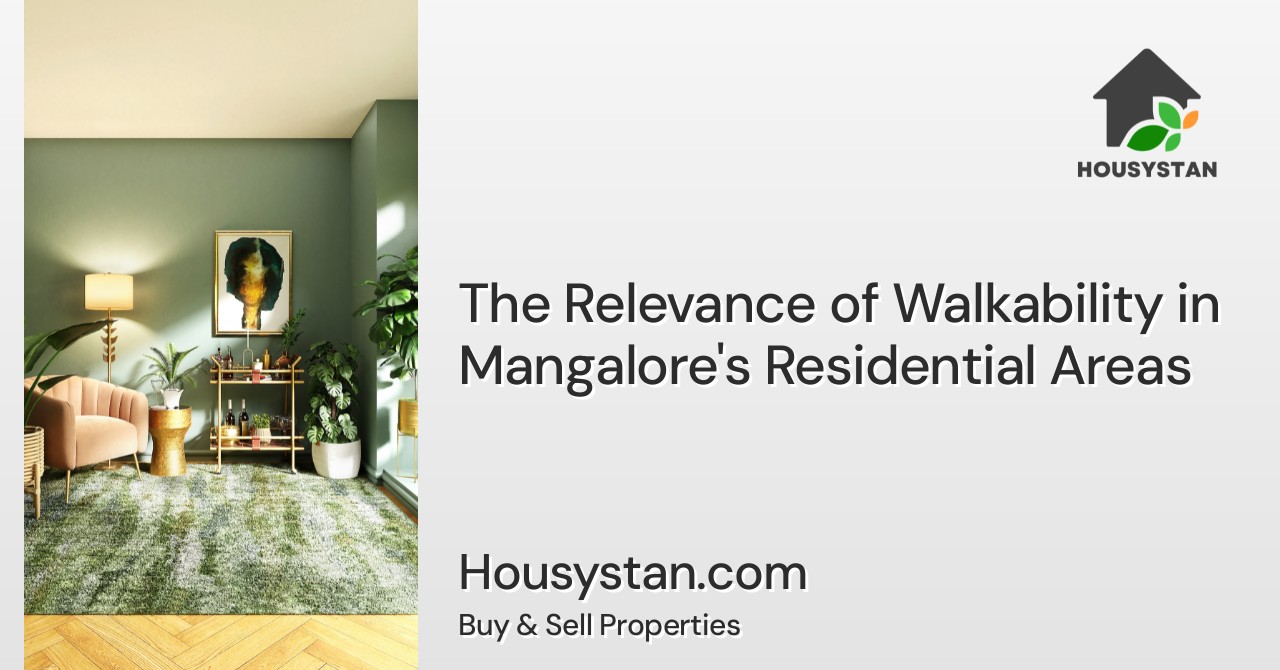The Relevance of Walkability in Mangalore's Residential Areas
Read latest blogs and articles from Housystan

The Information mentioned here was last updated on:
11/12/2025The Relevance of Walkability in Mangalore's Residential Areas
Walkability has become a buzzword in urban planning and development discussions around the world. But what does it mean for a city like Mangalore, a vibrant coastal city in Karnataka known for its diverse culture and bustling port? In the context of residential areas, walkability refers to the ease and safety of walking as a mode of transport, encompassing factors like pedestrian-friendly infrastructure, accessibility to necessities, and overall aesthetics. Here's why walkability holds significance for Mangalore's neighborhoods and how it can impact daily life.
Understanding Walkability
- Verified Tenants/Buyers
- Unlimited Property Listing
- Zero subscription/charges fee
Walkability is determined by several factors, such as:
- Sidewalk Quality: Well-maintained and wide sidewalks encourage walking.
- Accessibility to Amenities: Proximity to key locations like schools, parks, grocery stores, and healthcare centers.
- Safety: Safe crossing points and low traffic speeds enhance perceived safety.
- Aesthetic Environment: Green spaces and clean streets create a pleasant walking experience.
Why Walkability Matters
Health Benefits
Incorporating walking into daily routines can significantly improve residents' overall well-being. Walking is known to:
- Boost cardiovascular health.
- Enhance mental clarity and reduce stress.
- Aid in weight management through increased physical activity.
For Mangalore, encouraging walking can contribute to a healthier population, reducing dependence on motor vehicles and, consequently, air pollution.
Economic Advantages
Areas with higher walkability often witness:
- Increased property values due to the desirability of living in pedestrian-friendly areas.
- Growth in local businesses, as walkable areas are conducive to forming small marketplaces and shops.
- Cost savings on transport for residents as walking reduces the need for personal vehicles.
For Mangalore's residential areas, enhancing walkability can spur local economic growth and sustainable development.
Social and Community Impact
Walkable neighborhoods encourage community interaction:
- Increase social cohesion as people meet and interact while walking.
- Enhance safety through natural surveillance with more people on the streets.
- Foster a sense of belonging and pride in local environments.
Mangalore's Current Scenario
Urban Layout and Challenges
Mangalore's urban layout presents unique challenges and opportunities for enhancing walkability:
- Topography: With its hilly terrain, some areas might be less conducive to walking, requiring innovative urban design solutions.
- Infrastructure: Some parts lack adequate sidewalks, lighting, and signage, affecting walkability.
- Traffic: High traffic areas, especially near the city center, can be intimidating for pedestrians.
Opportunities for Improvement
To improve walkability in Mangalore's residential areas, focus on these key areas:
1. Infrastructure Development: Prioritize the construction and maintenance of sidewalks, pedestrian crossings, and street lights.
2. Traffic Management: Implement traffic calming measures such as speed limits, pedestrian zones, and overpasses/underpasses.
3. Zoning and Planning: Encourage mixed-use developments to bring amenities closer to residents.
Integrating Walkability into Future Plans
Policy and Governance
City planners and local governments play a vital role. Key areas to address include:
- Urban Policies: Develop policies that explicitly prioritize pedestrian infrastructure.
- Community Involvement: Engage local communities in the planning process to ensure the needs of residents are met.
- Public Awareness: Run campaigns to educate citizens on the benefits of walking and how to support walkable initiatives.
Technological Advancements
Technology can be leveraged to boost walkability:
- GPS and Mapping Services: Develop apps that highlight walkable routes and nearby amenities.
- Data Collection: Use sensors and IoT to monitor and collect data on pedestrian traffic patterns to inform planning.
The Role of Community and Local Organizations
Resident Initiatives
Residents can play an active role in promoting walkability by:
- Organizing community clean-up drives to beautify walking routes.
- Advocating for more pedestrian-friendly infrastructure at municipal meetings.
- Forming neighborhood associations that focus on improving walkability.
Collaborations and Partnerships
Partnerships between local businesses, NGOs, and government bodies can foster innovative solutions:
- Collaborative projects that create shared spaces or community gardens.
- Business incentives for projects that enhance local walkability.
- Joint funding initiatives to upgrade pedestrian infrastructure.
Conclusion
Promoting walkability in Mangalore's residential areas offers numerous benefits, from improved public health and economic growth to stronger communities and sustainable urban development. By prioritizing pedestrian infrastructure and engaging all stakeholders in meaningful dialogue, the city can create a thriving, walkable environment for its residents. As Mangalore continues to grow and evolve, integrating walkability into its urban fabric will not only enhance the quality of life but also pave the way for a more sustainable and connected city.
For more insights on urban development and community planning, explore our other articles available on our [City Life Blog](). By staying informed, you can actively contribute to shaping Mangalore's future. Together, let's walk towards a better tomorrow!